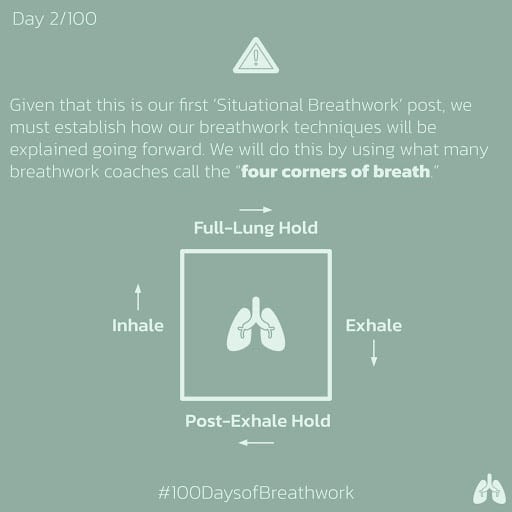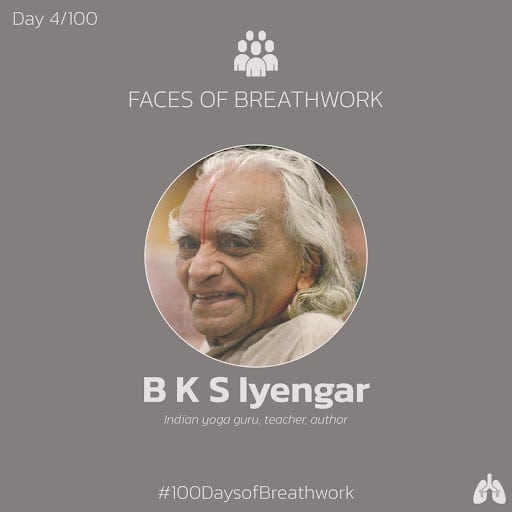100 Days of Breathwork W1
Breathwork is an ancient mindfulness practice that is seeing a renaissance of sorts in the last few years, and for good reason. Practitioners are seen to be growing in numbers as more people discover its positive effects. Recal founder Anthony Lorubbio is a certified breathwork coach and has dived into a 100 Days of Breathwork content campaign. In this blog post series, we will break down the day-by-day information that he puts out into the world. We hope you enjoy and also learn more about breathwork and how it can become a part of your mindfulness practice.
Written by Anthony Lorubbio
Day 0: Overview of the 100 Days of reathwork
Many people are getting curious about breathwork these days. I am definitely one of them.
As part of my Wim Hof Method practice and instructor training, I was introduced to breathwork as a mindfulness practice to quiet my monkey mind, calm anxiety, and increase energy and focus. It has been a life-changing tool for me, and I’ve since read books, done live guided sessions, and learned from some of the best instructors in the world.
But there is still so much more to learn and do in this field.
Starting tomorrow, I will be joining a movement called The 100 Day Project. This is a global community of artists, makers, creatives, and people learning something new or honing their craft.
As a still-new coach in breathwork, I thought this would be the perfect opportunity for me to continue my work and share it with the world.
The main topics I’ll be covering are:
- The History of Breathwork
- Breathing Techniques for Specific Situations
- The Science Behind Breathwork
- The Faces Behind Breathwork
- A Guided Session (Pre-recorded or Live)
- Common Questions
If you want to follow along, I’ll be using the hashtag #100DaysofBreathwork.
And last but not least: a big shoutout to my sister, Gina @heirloomfoodproject for her encouragement and inspiration to join 🙂
Day 1: The History of Breathwork
Breathwork and its roots in Pranayama
Breathwork has its roots in Pranayama. Thousands of years ago, yogis in India did pranayama as a deeply spiritual practice of controlled breathing. In Sanskrit, the word pranayama consists of prana- which means “vital life force” and -yama, which means “to gain control.” This is the oldest form of breathwork, even mentioned in the Rig Veda, an ancient Indian text, as early as 1500 BC.
The modern resurgence of breathwork began in the 1960s in primarily two forms: holotropic and rebirthing, both used as a method for healing and inner awakening.
In the last five years, there has been an emergence of various styles of breathwork including the Wim Hof Method, Shamanic, Vivation, and Transformational, among others.
Day 2: Situational Breathwork
Breathwork technique to prep for meditation

Our first situation is one in which you are attempting to calm your mind and body in preparation for meditation. It is called 4-7-8 Breathing, created by Dr. Andrew Weil.
Given that this is our first ‘Situational Breathwork’ post, we must establish how our breathwork techniques will be explained going forward. We will do this by using what many breathwork coaches call the “four corners of breath.”
Using the four corners of breath, we will work with a notation technique using counts. For example, a pattern that would include a 4-count inhale, 6-count full-lung hold, 4-count exhale, and 6-count post-exhale hold would be written as 4-6-4-6,
OK now that we know our notation technique going forward, let’s outline a breathwork pattern that will help calm your mind as you prepare for meditation. It is called 4-7-8 breathing and has a notation of (you guessed it): 4-7-8-0
This is a very popular breathing pattern taught and practiced by many people around the world. In addition to its calming and background-noise-stifling effects on your mind, it may also help you relax before going to sleep.
It is recommended to breathe through your nose on the inhale, and your choice on the exhale, nose or mouth. I personally use my nose for both while doing 4-7-8 Breathing.
Inhale for a count of 4, hold for a count of 7, exhale for a count of 8, and then begin again. This can make a significant impact after only a few rounds
Day 3: Science of Breathwork
Blood pH level increases during breathwork
Today we’re getting scientific. Specifically: how does a breathwork exercise impact the pH level of our blood?
Breathwork is something we can do to alkalize our blood for a short time, acting as a manual recalibration if we’re in an acidic state. The result is a more healthy, balanced life.
At baseline, the pH value of our blood is 7.4. During many common types of breathwork, we expel carbon dioxide (CO2), resulting in the blood becoming more alkaline (as opposed to acidic). pH level can go as high as 7.8 during breathwork and normalize shortly thereafter.
Less than 7.4, blood is slightly alkaline. Our body works best with this healthy balance of alkalinity vs acidity. The vital organs in our body contribute to (and work hard!) to maintain this balance However, if we fall below the baseline and live in an acidic state (unhealthy lifestyles contribute to this), we are more susceptible to diseases and our organs work extra hard.
Breathwork is something we can do to alkalize our blood for a short time, acting as a manual recalibration if we’re in an acidic state. The result is a more healthy, balanced life.
Day 4: Faces of Breathwork
B K S Iyengar

Our featured ‘Face of Breathwork’ today was a natural fit to be the first of this series.
B K S Iyengar is one of the most influential people of the 20th century in the realm of yoga and pranayama—and therefore breathwork.
Even into his nineties, Iyengar was practicing pranayama for an hour a day.
Iyengar believed that pranayama was the means by which we can find the stillness of both body and mind, ultimately merging it with the spirit. He also has said that we generate energy, expansion, and awareness through breathwork.
Day 5: Breathwork Session
Breathwork with Chris Wurden
Today, we’re passing the mic to Chris Wurden to lead you through a breathwork session via a link to a recently recorded session – you can view it here on Day 5. Chris is an accomplished and experienced breathwork facilitator and mindfulness coach (he’s also the coach of some Hoh Rainforest backpacking trips to Olympic National Park with my company, Recal).
In this breathwork session, Chris applies all of his breathwork experience — Buteyko, Oxygen Advantage, Wim Hof — to the session, while playing his own music. He’s an incredibly talented coach and amazing human.
Day 6: Common Questions
What are the benefits of breathwork?
Every 6th day of our 100 Days of Breathwork, we will be covering Common Questions. These might be from questions I’ve received directly, been posted on discussion boards, I’ve heard asked by Wim Hof practitioners and instructors, etc.
In this section, we will address ‘What are the BENEFITS of breathwork?’
To that I say… there are many! But for now, we’ll focus on the MENTAL benefits.
No matter which breathwork modality we’re talking about – Wim Hof/Tummo, holotropic, shamanic, etc. – these incredibly simple but profound exercises can have a calming effect on our mind. During a brain scan study done in Michigan in 2018, it was shown that our higher-order cortical brain was more active, which is associated with internal focus and self-reflection. That’s why many people attribute breathwork with bringing their “monkey mind” to rest and finding inner peace. As such, breathwork is known to help lower anxiety and increase our mental well-being.
Additionally, by its activation of the Vagus Nerve, we’re able to consciously balance our nervous system between sympathetic (fight/flight) vs parasympathetic (rest/digest). This helps our body and mind get on the same page for the stress response that is appropriate for our environment.
Conclusion
Even in antiquity, the benefits of proper breathing techniques have been known to practitioners. Modern science has also confirmed that breathwork does have tangible positive effects on overall wellbeing. Both modern research and ancient knowledge and experience confirm its effectiveness.
